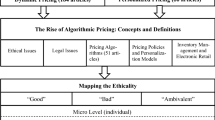Abstract
Supply chain mechanisms that exacerbate price variation needs special attention, since price variation is one of the root causes of the bullwhip effect. In this study, we investigate conditions that create an amplification of price variation moving from the upstream suppliers to the downstream customers in a supply chain, which is referred as the “reverse bullwhip effect in pricing” (RBP). Considering initially a single-stage supply chain in which a retailer faces a random and price-sensitive demand, we derive conditions on a general demand function for which the retail price variation is higher than that of the wholesale price. The investigation is extended to a multi-stage supply chain in which the price at each stage is determined by a game theoretical framework. We illustrate the use of the conditions in identifying commonly used demand functions that induce RBP analytically and by means of several numerical examples.
Similar content being viewed by others
References
Bazaraa, M. S., Sherali, H. D., & Shetty, C. M. (1993). Nonlinear programming: theory and algorithms (2nd ed.). New York: Wiley.
Bureau of Labor Statistics (2008). Monthly report of consumer price index and producer price index. http://www.bls.gov.
Chen, F., Drezner, Z., Ryan, J. K., & Simchi-Levi, D. (2000). Quantifying the bullwhip effect in a simple supply chain: the impact of forecasting lead times, and information. Management Science, 46(3), 436–443.
Chiang, W., Chhajed, D., & Hess, J. D. (2003). Direct marketing, indirect profits: A strategic analysis of dual-channel supply chain design. Management Science, 49(1), 1–20.
Corbett, C. J., & Karmarkar, U. S. (2001). Competition and structure in serial supply chains with deterministic demand. Management Science, 47(7), 966–978.
Coughlan, A. T., & Lal, R. (1992). Retail pricing: does channel length matter? Managerial and Decision Economics, 13(3), 201–214.
Cowan, S. (2004). Demand shifts and imperfect competition. Oxford: University of Oxford, Department of Economics Discussion Paper Series. March, Number 188, ISSN 1471-0498. Available at URL: http://www.economics.ox.ac.uk/Research/wp/pdf/paper188.pdf.
Disney, S. M., & Towill, D. R. (2003). The effect of vendor managed inventory (VMI) dynamics on the bullwhip effect in supply chains. International Journal of Production Economics, 85(2), 199–215.
Disney, S. M., Farasyn, I., Lambrecht, M., Towill, D. R., & de Valde, W. V. (2006). Taming the bullwhip effect whilst watching customer service in a single supply chain echelon. European Journal of Operational Research, 173(1), 151–172.
Edwards, E. O. (1950). The analysis of output under discrimination. Econometrica, 18, 161–172.
Gerstner, E., & Hess, J. D. (1995). Pull promotions and channel coordination. Marketing Science, 14(1), 43–60.
Ingene, C. A., & Parry, M. E. (1995). Channel coordination when retailers compete. Marketing Science, 14(4), 360–377.
Iyer, G. (1998). Coordinating channels under price and nonprice competition. Marketing Science, 17(4), 338–355.
Jeuland, A. P., & Shugan, S. M. (1983). Managing channel profits. Marketing Science, 2(3), 239–272.
Kim, J. G., Chatfield, D., Harrison, T. P., & Hayya, J. C. (2006). Quantifying the bullwhip effect in a supply chain with stochastic lead time. European Journal of Operational Research, 173(2), 617–636.
Lal, R. (1990). Improving channel coordination through franchising. Marketing Science, 9(4), 299–318.
Lee, H. L., Padmanabhan, V., & Whang, S. (1997). Information distortion in a supply chain: The bullwhip effect. Management Science, 43(4), 546–558.
Lee, H. L., Padmanabhan, V., & Whang, S. (2004). Comments on “Information distortion in a supply chain: the bullwhip effect”, The bullwhip effect: Reflections. Management Science, 50(12), 1887–1993.
Ozelkan, E. C., & Cakanyildirim, M. (2007). Reverse bullwhip effect in pricing. European Journal of Operational Research. Available online: doi:10.1016/j.ejor.2007.09.009.
Petruzzi, N. C., & Dada, M. (1999). Pricing and the newsvendor problem: a review with extensions. Operations Research, 47(2), 183–194.
Sheu, J. B. (2005). A multi-layer demand-responsive logistics control methodology for alleviating the bullwhip effect of supply chains. European Journal of Operational Research, 161(3), 797–811.
Svensson, G. (2003). The bullwhip effect in intra-organizational echelons. International Journal of Physical Distribution & Logistics Management, 33(1/2), 103–131.
Tyagi, R. K. (1999). On the effects of downstream entry. Management Science, 45(1), 59–73.
Author information
Authors and Affiliations
Corresponding author
Rights and permissions
About this article
Cite this article
Özelkan, E.C., Lim, C. Conditions of reverse bullwhip effect in pricing for price-sensitive demand functions. Ann Oper Res 164, 211–227 (2008). https://doi.org/10.1007/s10479-008-0444-9
Published:
Issue Date:
DOI: https://doi.org/10.1007/s10479-008-0444-9




